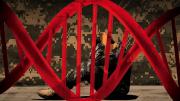W
hen soldiers returned from the Vietnam War with symptoms such as flashbacks, nightmares, and hypervigilance, researchers began calling the condition post-traumatic stress disorder (PTSD), a diagnosis that was viewed by some with skepticism. The doubts and stigma made many veterans hesitant to report their symptoms. Now, decades later, a new blood test shows promise in diagnosing PTSD by spotting genetic and cellular changes that accompany the disorder, suggesting that this condition is not just “all in the head.”
That test reflects nearly a decade’s study of PTSD by more than 75 researchers, including Frank Doyle, Armstrong professor of engineering and applied sciences and dean of the Harvard Paulson School of Engineering and Applied Sciences (SEAS), and graduate student Kelsey Dean. Hailing from institutions including New York University, the University of California, San Francisco, and the U.S. Army, the scientists analyzed blood work and other biological data from men who had served in combat in Afghanistan and Iraq, in an effort to identify indicators strongly linked to the condition.
One focus of Doyle’s lab is systems biology. That field often involves processing giant quantities of diverse data types to identify connections and understand how systems function, so Doyle and Dean oversaw much of the data and systems analysis for this project. In this case, the data included biomarkers such as genes, metabolites, hormones, proteins, cell-aging indicators, and immune-cell counts. Researchers began by collecting blood samples and other readings, such as resting heart rate, from 83 combat veterans with a PTSD diagnosis, and 82 who experienced combat but did not have PTSD. The resulting data yielded more than a million data points to analyze per person.
The consortium of labs then scrutinized the data using a “wisdom of crowds” approach (also employed in economics and finance), which values collective wisdom over individual insight. “We challenged all the labs involved to use their own methodologies, to bring their own insights to the problem,” Doyle explains. “We wanted to really benefit from this massive brain trust that we had assembled and see what the union of all possible biomarkers would be.” Pooling all those findings narrowed the million indicators down to 343. The researchers then used additional statistical techniques to pinpoint a set of 28 indicators highly predictive of PTSD.
When those 28 were tested on a new group of 29 male veterans with PTSD and 29 without, and the results compared to those from the questionnaire clinicians currently use to diagnose PTSD, the researchers found the blood test had accurately diagnosed the disorder 77 percent of the time. The 28 markers include immune signatures, stress signatures, and markers of cardiovascular health—all of which made sense based on previous research on PTSD. For example, “Evidence suggests links between PTSD and Type 2 diabetes and cardiovascular disease,” Dean says, “so it’s really interesting that we see these markers come up and show that linkage.”
Achieving a positive blood test for PTSD could identify people who need additional assessment and treatment, but more research is needed before these findings can be applied in the field. Not only must the panel be tested on a much larger group of veterans, but more work is required to understand what PTSD looks like in women and when caused by scenarios other than combat. “We’re not declaring victory—game over—that these 28 are the magical 28 markers for men, women, civilians, firefighters, policemen, military, veterans,” Doyle says. “This is just the beginning. We don’t talk about one type of diabetes; we don’t talk about one cancer. One might expect that there’s not necessarily one stress disorder.”
Doyle and Dean theorize that their results mark the beginning of new approaches for a variety of psychiatric illnesses. The diagnostic surveys that practitioners currently use are sophisticated and effective, but require that patients accurately report their symptoms. Blood tests could help identify more people who are suffering. “We’re starting to evolve in the way we think about mental-health disorders: treating and analyzing them in a way that’s more similar to how we think about problems like cancer,” Dean says. “To think that a disease that people associate with mental health and the brain could actually have a signal that gets into blood, that could be used to diagnose it and identify new drugs to treat it—this is a huge paradigm shift.”









